You might be surprised at how drastically the look of your painted furniture can change with Black Glaze.
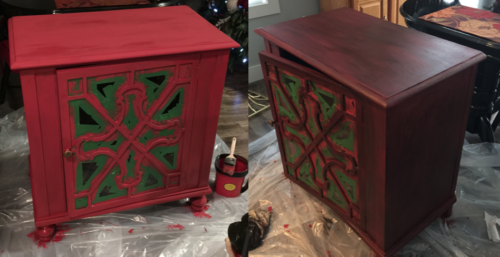
In this weeks ‘Share Your Project’ post, Georgina Kenny shows us what happens when you add an Eco-Friendly stain on top of furniture paint.
Plus, you’ll learn the 3 basic steps to applying Glaze so you can have the confidence to try it out on your next furniture painting project!
For this project, the stain used is called ‘Black Glaze’ and the paint is Firework’s Red. (A popular color of Clay/Chalk/Mineral Paint from American Paint Company)
Adding an Eco-Friendly Stain on Top of Painted Furniture
Glaze is highly versatile and highly concentrated. In other words, it’s a thick liquid. Glaze can be used to create a stain like finish, and add beautiful detail to your hand painted furniture.
The Glaze from American Paint Company is completely All Natural and Eco-Friendly. So unlike traditional stains that leave an offensive odor lingering your home, it’s safe to use the odorless Glaze inside!
Glaze comes in different colors and sizes
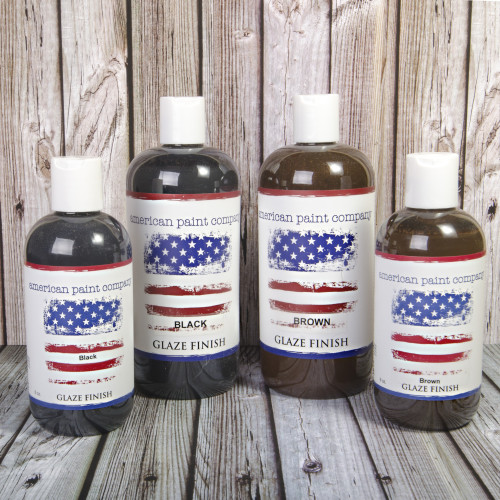
American Paint Company’s Glaze Finish comes in two colors and two sizes. You can either use Black to darken your painted piece, or Brown to give it the stained look. Both colors come in a large 16oz bottle, or a small 8oz bottle.
American Paint Company also carries a 16oz Clear Glaze, which allows you to add any paint color into the Glaze so you can custom color your Glaze with over 35 colors!
The 3 Basic Steps to Applying Glaze on Your Painted Furniture
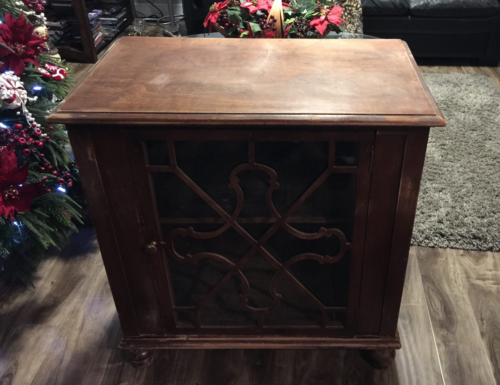
STEP 1: Paint Your Project
This cabinet belonged to Georgina’s parents, and when her father passed away she brought it home.
It’s an antique cabinet with glass door, two shelves, and lots of potential!
Georgina planned to paint the cabinet with Firework’s Red, seal it with a durable clear Top Coat sealer, and finish it with Black Glaze.
TIP: You can use Glaze directly on your piece of furniture without painting it first to give your wood a natural stain look!
Even though she planned to apply Glaze later, there was no need to do any special prep work, sanding or priming to the piece. She could just begin painting directly onto the antique cabinet after a thorough cleaning of the old piece. There were no paint fumes to worry about, so painting inside her home during the holiday season was safe and enjoyable.
STEP 2: Apply the Top Coat Sealer
If you are applying Glaze on top of paint, you’ll need to put down a layer of Top Coat sealer first.
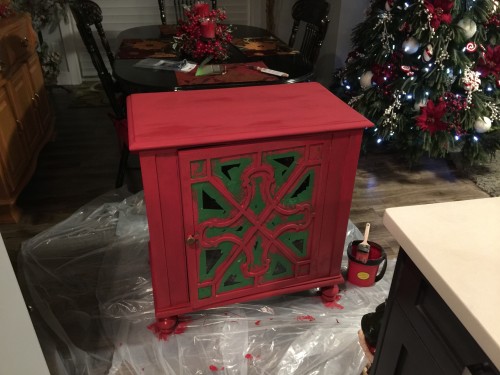
Every piece of furniture that is painted using Clay, Chalk & Mineral paint needs to be sealed. The Top Coat is a popular liquid sealer because it’s durable and creates a barrier between the paint to protect it from rubbing off.
It’s important to understand that the Glaze is thick. Without adding a layer of Top Coat, the paint will quickly absorb the Glaze causing dark, blotchy spots on the piece.
But when you put down the Top Coat barrier first, it’s easier to move the Glaze around on the piece.
STEP 3: Apply Your Glaze Finish
Once the Top Coat sealer has dried, it’s time to apply the Glaze!
Now that you’ve applied the Top Coat sealer to protect the paint, you’ll have more time to work with the Glaze as you apply it. You can move it around the piece, and get the look that you want.
You can also brush on the Glaze using a bristle brush, foam brush or clean rag. Be sure to work the Glaze into the grooves and details of your piece to get the best results.
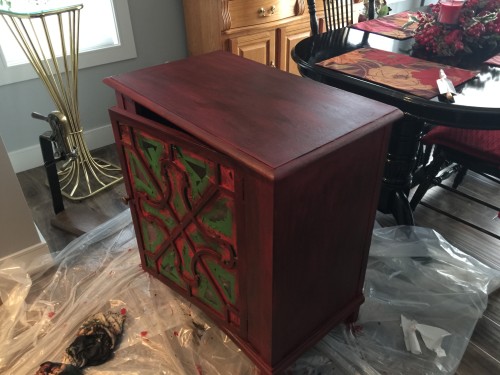
Once you’ve applied the Glaze, take a slightly damp cloth to remove and wipe back any excess glaze. Keep working with it until you get the look you’re trying to achieve.
The Glaze is flexible and forgiving to use, just like the paint. If you feel like you’ve taken too much off, go ahead and apply another coat and repeat the process.
After the Glaze has dried, it will be difficult to remove. You’ll have to work quickly with the Glaze before it has a chance to dry.
Do I Need To Seal After Applying Glaze?
In some cases, the Glaze will work fine as a sealer along with the coat of Top Coat that you’ve already applied. However, if your furniture is going to be used often, we recommend applying another 2-3 layers of Top Coat sealer on top of the Glaze finish.
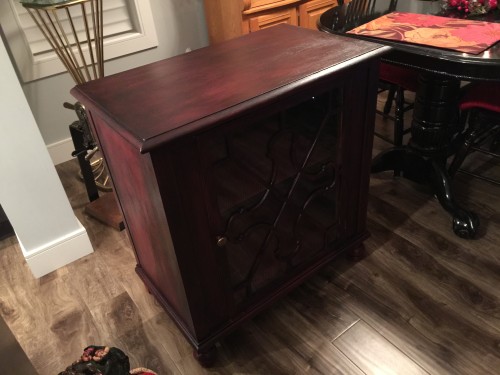
____________________________________________
Share your project pictures with us and you could win a $100 Gift Box!
We want to showcase your projects of love. Use the Project Submission tool on our site today and you could be our next feature. You’ll automatically be entered to win the monthly Gift Box!
On social media use #americanpaintcompany

This piece is exactly how I want to redo my golden oak kitchen cabinets. Where can I purchase your products.
I live near Overland Park, Ks.
Thanks, Ann
Hi Ann,
The closest retailer to you might be in Manhattan, Kansas.
Here’s a link to our retailer map:
https://americanpaintcompany.com/find-a-retailer/
Can you place the dark glaze on furniture that you don’t want painted? An existing dining room table.
I live in Canada in Nova Scotia is there a retailer close by I can visit to pick up your paint and glaze? Thanking you in advance?
I am trying to get educated on how to paint a decorative wood ladder. Is there any special prep work needed on the wood before painting or can I go directly to paint?
Do you need to use a top coat if the furniture was pained with an oil base high gloss?
Sounds like a great project Nancy. You can mix the brown and black glaze together with some water (all equal parts) Wipe on and Wipe off until you get the desired look! That would look amazing with a metallic copper kitchen hood. Happy Creating!